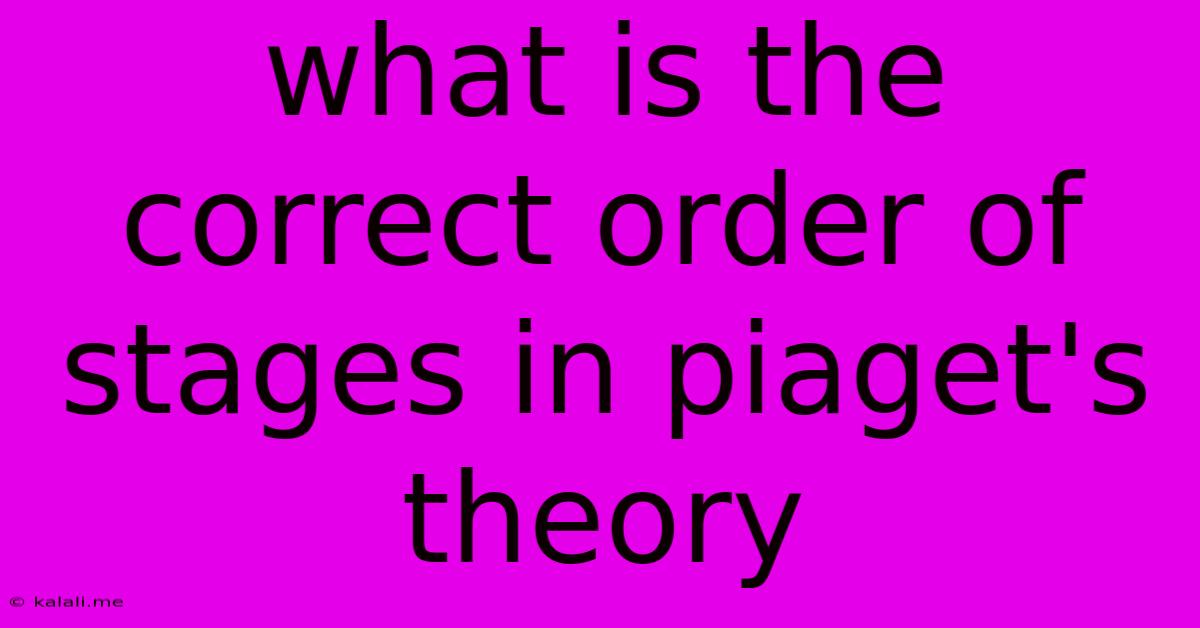What Is The Correct Order Of Stages In Piaget's Theory
Kalali
Jun 13, 2025 · 3 min read

Table of Contents
The Correct Order of Stages in Piaget's Theory of Cognitive Development
Piaget's theory of cognitive development is a cornerstone of developmental psychology, proposing that children progress through four distinct stages of mental development. Understanding the correct order of these stages is crucial to grasping the essence of Piaget's work and its implications for education and child psychology. This article will outline each stage, highlighting key characteristics and the sequential progression that forms the foundation of Piaget's theory.
Understanding Piaget's Stages: Piaget believed that children actively construct their understanding of the world through interaction and experience. This process isn't a passive absorption of information but an active process of building mental models, schemas, and understanding. The four stages, each characterized by unique cognitive abilities, are:
1. Sensorimotor Stage (Birth to 2 years)
This initial stage focuses on sensory and motor skills. Infants understand the world through their senses (seeing, hearing, touching, tasting, smelling) and actions (sucking, grasping, looking). Key developments include:
- Object Permanence: The understanding that objects continue to exist even when out of sight. This develops gradually throughout this stage.
- Stranger Anxiety: Developing a fear of unfamiliar people, indicating the formation of attachments and recognition of individuals.
- Goal-Directed Behavior: The ability to plan and execute actions to achieve a desired outcome, like reaching for a toy.
Children in this stage are egocentric; they haven't developed the understanding that others have different perspectives. Their thinking is largely based on immediate sensory experiences.
2. Preoperational Stage (2 to 7 years)
This stage marks the beginning of symbolic thought. Children begin to use words and images to represent objects and ideas. However, their thinking is still limited by:
- Egocentrism: Difficulty seeing things from another person's point of view. A classic example is the "three mountains task," where children struggle to describe what someone on the opposite side of a table sees.
- Centration: Focusing on only one aspect of a situation at a time, neglecting other important details. For example, a child might focus on the height of a glass of liquid but not its width, failing to understand that both glasses hold the same amount.
- Lack of Conservation: The inability to understand that quantity remains the same despite changes in appearance. For example, pouring the same amount of liquid into a taller, thinner glass might lead a child to believe there's more liquid.
- Animism: Attributing lifelike qualities to inanimate objects. A child might believe the sun is following them or that a toy is sad.
3. Concrete Operational Stage (7 to 11 years)
Children in this stage develop logical thinking but primarily about concrete events. Abstract concepts remain challenging. Key developments include:
- Conservation: Understanding that quantity remains the same despite changes in shape or appearance.
- Decentration: The ability to consider multiple aspects of a situation simultaneously.
- Reversibility: Understanding that actions can be reversed.
- Classification: The ability to organize objects into categories based on shared characteristics.
- Seriation: The ability to arrange objects in order based on a specific characteristic, such as size or weight.
4. Formal Operational Stage (11 years and onward)
This is the final stage, characterized by the ability to think abstractly and hypothetically. Adolescents and adults can now:
- Engage in hypothetical-deductive reasoning: Formulating hypotheses and testing them systematically.
- Think abstractly: Grasping concepts like justice, freedom, and love, which aren't tied to concrete objects.
- Deal with hypothetical situations: Considering possibilities that aren't directly observable.
- Engage in metacognition: Reflecting on their own thinking processes.
Conclusion:
Piaget's stages, while not without their criticisms, provide a valuable framework for understanding how children's cognitive abilities develop. The sequential progression – sensorimotor, preoperational, concrete operational, and formal operational – highlights the gradual acquisition of increasingly complex cognitive skills. Remember that individual development varies, and some individuals may reach certain milestones earlier or later than others. However, the general order of these stages remains a consistent observation in developmental psychology.
Latest Posts
Latest Posts
-
Four Bells Toll Together At 9am
Jun 14, 2025
-
Identify A True Statement About Theories
Jun 14, 2025
-
Which Of The Following Is True Of Voip
Jun 14, 2025
-
Branch Of Medicine Concerned With Digestive Diseases
Jun 14, 2025
-
112 Is 56 Of What Number
Jun 14, 2025
Related Post
Thank you for visiting our website which covers about What Is The Correct Order Of Stages In Piaget's Theory . We hope the information provided has been useful to you. Feel free to contact us if you have any questions or need further assistance. See you next time and don't miss to bookmark.